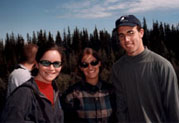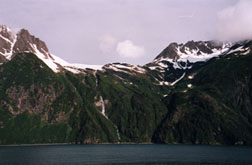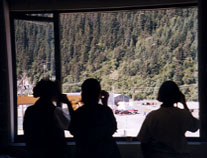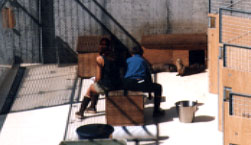Students in Arctic Research (STAR) | Noa Levanon

Noa (middle) with Elisa (left), and Aaron Stupple (right) from the Deering Archeological Expedition
Noa Levanon
Bloomington, Indiana
Project: Study of Oil Spill Effects on River Otters in Prince
William Sound
Principal Investigator: Dr. Merav Ben-David,
University of Alaska, Fairbanks, Alaska
TEA Teacher: Myrtle
Brijbasi, Temple Hills, Maryland
Biography
Noa was especially interested in the opportunity to conduct research on mammals in Alaska because of the stark contrast to the genetic studies she has been performing on fruit flies with researchers at Indiana University in Bloomington, Indiana. Noa grew up in Bloomington and graduated valedictorian of the class of 1998 from Bloomington High School North. For the last two years she has explored many aspects of molecular biology in three different laboratories at Indiana University. She developed a study on site specific cre-dependent recombinant genetics in the fruit fly that took her to 3rd place in the regional and state science fairs and won the Crane Naval Base science fair. Her aptitude for intellectual competition led Noa to co-captain the Academic Superbowl Team and be an active member of the Science Olympiad. She spoke at the Indiana Junior Academy of Science and was a finalist for the outstanding scientist award. An accomplished violinist, Noa played in the Hoosier Youth Philharmonic orchestra, the all state orchestra and school orchestra, for which she was also the concert mistress and treasurer. Noa served on her school student government, and performed the duties of secretary for both her school's chapter of the National Honor Society and the Bloomington Organization of Synagogue Youth. Noa also enjoys reading, speaking French and Hebrew, and was on the varsity cross-country and track team. She is looking forward to continuing her science education at Princeton University in New Jersey this fall in pursuit of a M.D./Ph.D. in genetics or oncology.
The Alaskan Experience: a Road to a Bigger
Horizon
Abstract: By Noa Levanon
This summer I had the privilege of going to Alaska to work with Merav Ben-David, an otter biologist, on a project studying the effects of oil on river otters. This was one of the most amazing adventures of my life. Alaska, in and of itself, was incredible. The environment was so beautiful, with such unique plants and animals. However, the best part of the trip was the educational experience. I learned both about science and about life. As a prospective molecular biology major, I had no experience in the area of marine research, my interests lying at the other side of the life science spectrum. However, I discovered that I loved working with mammals in this capacity. It changed my perspective on my scientific focus, which previously had been quite rigid. It opened my eyes to a wonderful side of biological exploration that I had overlooked.
I started out in Bloomington, Indiana, a small town in the southern part of the state, and directly in the heart of the American Midwest. The fifteen-minute hiking trails by the lake can be completed in five minutes and the largest body of water is a man-made reservoir. And while the area is definitely more mountainous than the utterly flat farmland comprising the upper two-thirds of the state, the hills of the region can be defined as mediocre at best. Granted, flat terrain is good for farming, but it does not adequately prepare one for the magnificence of the Alaskan scenery.
I arrived in Alaska on July 10 and I was immediately
awestruck. Physical beauty in nature has always had a
very captivating effect and this was a trait that the
Alaskan wilderness has in abundance.  It was the most stunning
sight that I had ever seen, the sort of scene that
convinces you that there is a definite plan and power
in the universe. No accident could have created such
a breathtaking masterpiece. The scene altered my
definition of natural color. Everything looked so
clear and pure that the brilliant colors seemed to
sparkle.
It was the most stunning
sight that I had ever seen, the sort of scene that
convinces you that there is a definite plan and power
in the universe. No accident could have created such
a breathtaking masterpiece. The scene altered my
definition of natural color. Everything looked so
clear and pure that the brilliant colors seemed to
sparkle.
Another striking feature about everything in Alaska was its sheer magnitude. The state itself is three times the size of Texas, and its flora and fauna correspond to this enormity. Anchorage's high rises were dwarfed in the shadow of the surrounding mountains. They were also easily seen from the airplane as they regularly peeped above the clouds. On the drive down the Alaskan highway to Seward, the route was fringed with coastal boreal rainforests. The mass of coniferous trees resembled an army of regal, green giants. The stately moose that we observed during the drive was so immense that it could have been the Indiana deer on steroids. Even the stellar sea lions, while adorable and friendly, took me by surprise by being much larger than I was.
Despite the discrepancies between the environments of Indiana and Alaska, the change of physical atmosphere was smaller than the change of scientific experience. My most meaningful high school extra-curricular activity had been, without a doubt, being part of a research lab. My pursuit of this pastime was sparked by my love of theoretical molecular biology and I moved from molecular plant pathology, to molecular neuroscience, to Drosophila genetics. Thus I had spent two years working with bacterial cells and DNA. The project in Alaska entailed observing behavioral interactions between male river otters.
Having never studied any animal larger than a fruit fly before, there was quite a large gap in my experience with the animal kingdom, including the entire mammalian class. Obviously, working with organisms larger than 2 mm was going to be a distinct difference from anything I had ever done. Therefore, it was with both excitement and trepidation that I exchanged my microscope for a pair of binoculars.
I quickly discovered that my anxiety was unfounded. First of all, the basic approach to science was similar to my previous environments. Having any job entails responsibility and helps develop work ethic. However, lab work has a unique facet that is lacking in other types of employment and therefore, many of the scientific behaviors were the same. It fosters important characteristics such as efficiency, organization, and most importantly, patience and perseverance. It helped to have the same set of scientific "values."
In addition, this
experience stressed the concept of science as an
international language. Studying science has allowed
me to interact with a variety of people. I have had
the opportunity to meet and collaborate with
scientists of all ages, genders, and origins who had
similar interests and goals and this project was no
exception. The people that I met at the sea life
center came not only from a diversity of regions
across the continental US, but from all around the
world. Merav Ben-David, the principal investigator,
was Israeli while her graduate student, Susanne
Trillhose, and research assistant, Olav Ormseth, were
a German and a Minnesotan of Norwegian descent.
Myrtle Brijbasi, a high school teacher from the D.C.
area, had been born and raised in British Guyana and
Elisa Maldonado, the other high-school graduate, was
Hispanic. We were quite a diverse bunch.
However, it was the actual appeal of the marine biology project that silenced any doubts about the excellence of the experience. In a matter of days, I became genuinely attached to the river otters. Pictures are unable to do justice to the charm of these animals. They have long, sylph-like bodies and rope-like tails covered with thick, silky brown-gray fur. Their faces are conical, with black, triangular noses and large, dark eyes. Because of their short legs, they waddle when they walk. They are, in a word, adorable. However, it was their behavior that made me fall in love with them so utterly.
 Myrtle, Elisa, and I would
observe them for four to five hours a day and take
turns cleaning the pen and feeding the animals. Their
antics never ceased to be a source of amusement. The
otters had an inherent curiosity about strangers and
tendencies to scamper. Thus, when people were in the
vicinity, they would dart from box to box, and peep
out at the intruders of their privacy.>
Myrtle, Elisa, and I would
observe them for four to five hours a day and take
turns cleaning the pen and feeding the animals. Their
antics never ceased to be a source of amusement. The
otters had an inherent curiosity about strangers and
tendencies to scamper. Thus, when people were in the
vicinity, they would dart from box to box, and peep
out at the intruders of their privacy.>
Many of the animals had specific mannerisms. Cabin the otter had a way of upsetting the tote that contained fleece blankets for the otters. This reminded me of my sister in her younger years; she enjoyed making a mess of her toys directly after they had been put away. Littlebit, appropriately the smallest otter, also reminded me of my sister, because he was shy and tended to be in perpetual motion in order to avoid contact with strangers. Jim, a big, pudgy otter with a limp, was his exact opposite. Had he been a person, he would have been one of those fat, jolly businessmen who are nice to everybody and shake your hand over-enthusiastically. Naked, on the other hand, was mean. He was anemic and had a tendency to chew on the acrylic at the side of the pen in order to relieve stress. One day he arbitrarily decided to chew on Susanne as she was feeding him. At first, I thought that Lucky was also a mean animal because he liked to scream all the time, but after Elisa and I decided to scream back at him one day, I discovered some of the merits of this activity.
 Because of this
resemblance to humans, it became one of my objectives
to gain the animals' trust. When two of the animals
finally ate from my hand, I was ecstatic. It was
obvious that Merav had established the bonds of
friendship with them. This was something that I had
never been able to experience in my previous lab
settings. Fruit flies are grown in bottles and have
an 11-day life span. This environment hardly
encourages researcher-subject bonding. Thus, working
with mammals exposed me to an amazing and hitherto
unknown facet of animal research: endearment.
Because of this
resemblance to humans, it became one of my objectives
to gain the animals' trust. When two of the animals
finally ate from my hand, I was ecstatic. It was
obvious that Merav had established the bonds of
friendship with them. This was something that I had
never been able to experience in my previous lab
settings. Fruit flies are grown in bottles and have
an 11-day life span. This environment hardly
encourages researcher-subject bonding. Thus, working
with mammals exposed me to an amazing and hitherto
unknown facet of animal research: endearment.
I was honored to have the pleasure of working with such a fantastic group of people. I have learned so much from working and socializing with everyone. I would like to ARCUS AND the NSF for providing this incredible opportunity. A huge thank you to Merav Ben-David for being an inspiration and a fount of information. I have never met anyone who is as determined, straightforward, and knowledgeable in so many areas. Also thanks to Susanne and Olav for being so friendly and helpful when showing us the ropes. To Renee Crain, you amaze me. I really appreciated your energy, charisma, and planning skills. Myrtle and Elisa, I know that sharing experiences and friendship with you has helped me grow as a person.
Working in this atmosphere has affected my approach to life and to science. It introduced me to a side of biology with which I was not familiar. I feel that the experience has significantly strengthened my motivation to pursue a career as a research biologistÖbut I am not quite as set in one direction as before.
Thank you, TEA, for broadening my horizons.

